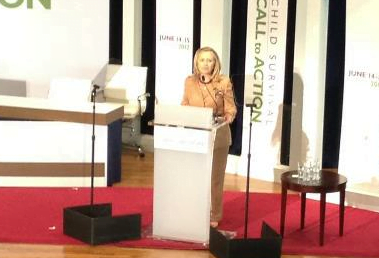At UNICEF’s last assessment, global child mortality (mortality of children under the age of 5) stood at 7.6 million deaths for the year 2010. In 2012, it is likewise estimated that over 7 million children will die before their 5th birthday. That’s roughly 21,000 children per day. Most of these deaths are the result of preventable causes, including health problems like diarrhea and pneumonia, and most occur in sub-Saharan Africa and south Asia.
While these numbers may seem gloomy, putting them in perspective creates room for optimism. The 7.6 million under-5 deaths in 2010 are a significant drop from the 1990 figure of 12 million, and USAID estimates that child mortality has fallen by 70% over the last fifty years. In India, child mortality was 118 per 1,000 in 1990 (against a global average of 88/1,000), but by 2010 it had fallen nearly to the global average. In fact, child mortality has been falling in many countries around the world.
This week in Washington DC, the governments of the United States, Ethiopia, and India are convening a conference in collaboration with UNICEF entitled Child Survival: A Call to Action, to keep up the momentum. The conference is being attended by over 700 participants from some 80 countries, including government officials, NGOs, and private sector professionals. Speakers include Raj Shah (Administrator, USAID), Ghulam Nabi Azad (Minister of Health and Family Welfare, India), Tedros Adhanom Ghebreyesus (Minister of Health, Ethiopia), Anthony Lake (Executive Director, UNICEF), Margaret Chan (Director General, World Health Organization), and many others. At the conference, it is hoped that participating countries will sign a new pledge committing to the continued effort to combat child mortality.
In a pre-conference press call, UNICEF Director Anthony Lake said the goals of the conference are:
1) to discuss ways to accelerate the global decline in child mortality
2) to launch a renewal of the promises made in 2002 — to work toward “A World Fit for Children” — and in 2000, with Millennium Development Goal number 4 — which aims to reduce child mortality by two thirds between 1990 and 2015.
The Ethiopian Health Minister, Tedros Adhanom Ghebreyesus, and Secretary for the Indian Health Minister Anuradha Gupta were also on the press call and were enthusiastic about the conference. Both countries have seen tremendous progress in reducing child mortality, and both health ministers stressed the crucial role of community health professionals in their respective successes. Mr. Tedros and Ms. Gupta also noted the role that political drive, global solidarity, and committed international partners played in the success of the community approach. Mr. Lake agreed, saying that although it seems the key to reducing child mortality and improving health is supplying drugs and resources to those who need it, the greatest barrier is the capacity of poor people to access these resources. In this way, the dispatch of community health professionals has been crucial.
Ms. Gupta and Mr. Tedros both stressed the success of a community approach. Ms. Gupta said in India, there has been commitment at the highest levels of government, with child and reproductive health being brought center stage. This translated to allocation of resources to these areas as top priorities. Further to that, flexible funding allowed states and provinces to design their own, context-specific and innovative solutions backed up by the federal resources to carry them out. This approach has been very effective, and child mortality has fallen more sharply among the rural poor in India than anywhere else.
Mr. Tedros said that Ethiopia took a similar approach. International partners were reluctant at first because it seemed too ambitious; the government wanted to deploy teams of community health workers to every village in the country. But the approach has led to the mobilization of communities around managing their own local health systems. International partners have seen how effective this has been and have provided much needed support. Political will and commitment on the part of the government, then, should be combined with community mobilization and support from international partners. Mr. Tedros noted that international partners like UNICEF and USAID have been major players in helping to make this community approach possible.
Mr. Lake said that despite remarkable progress, help is still not reaching millions of the poorest children. Participants at the conference will discuss practical strategies for reaching those children. The new pledge commits countries to work toward reducing child mortality to under 20 deaths per 1,000 by the year 2035. NGOs, governments, and international organizations need to work together, but Mr. Lake emphasized the need for governments to take a leadership role.
At the conference this week, governments that sign the pledge will set five-year measurable and monitorable benchmarks; those that don’t sign the pledge in Washington will be approached in their own capitals by international partners like UNICEF and encouraged to keep child mortality on the agenda. UNICEF will also be issuing annual reports on child mortality.
The global child mortality average is now 57 deaths per 1,000, a remarkable improvement from the 1990 figure of 88 per 1,000. But there are still over 7 million children to reach, and the Child Survival conference aims to discuss the best ways forward and rally as many countries as possible to renew their pledges. Mr. Lake referenced a report released by UNICEF last week which estimated that if coverage could be provided worldwide for diarrhea and pneumonia alone, 2 million children could be saved. This conference represents a great opportunity for governments, the private sector, and civil society to put their heads together; and the call to action will provide the momentum to help the international community achieve the goal of bringing child mortality down to under 20 deaths per 1,000 by the year 2035.
